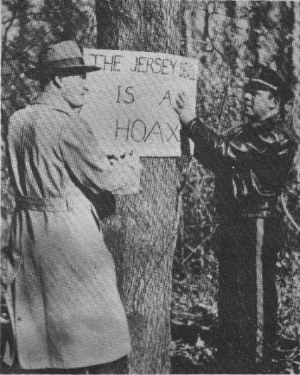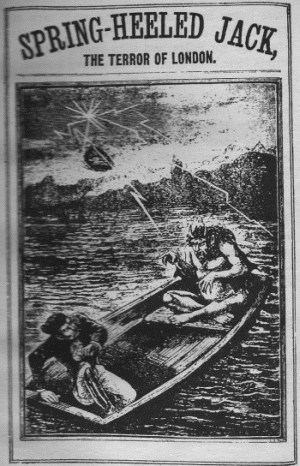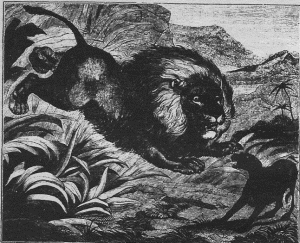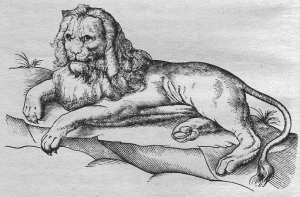Monsters You Never Heard Of (2 page)
Read Monsters You Never Heard Of Online
Authors: Daniel Cohen

Another theory is that the legend started when people encountered a large and unfamiliar bird. There is something rather birdlike about many of the descriptions of the Jersey Devil. The bird might have been a sandhill crane, which was once common in New Jersey.

Local officials try to put down a Jersey Devil scare in Gibbstown in 1951.
The sandhill crane stands about four feet tall.
It has a violent temper when cornered, and can chase away a man. There are rumors that people have actually been killed by the bird's long bill driven through the eye into the brain.
There is no shortage of theories to explain the Jersey Devil. None can be proved, or disproved.
In recent years there have not been too many sightings of the Jersey Devil. Perhaps the whole legend of the Jersey Devil will just fade away. But I will not predict that it will. Less than one hundred years ago someone else made that prediction and he was dead wrong.
In 1888, London was terrified by a series of mysterious murders. The killer was never caught. This unknown murderer was given the name Jack the Ripper.
A half century earlier an even more mysterious Jack was terrorizing London. This creature no one seemed quite sure what it was-was given the name Spring-Heeled Jack.
Rumors about the creature began late in 1837. There were many different descriptions, each one wilder than the one before. The thing was said to look vaguely like a powerfully built man. Some said it had wings, or horns, or that it breathed flames. But one thing that everybody said about the creature was that it jumped. It would jump out at women, usually at night. It was never reported to have killed anyone, but it did terrify its victims. Then it would jump away. It could make tremendous leaps, clearing fences and trees in a single bound. That is how it got the name Spring-Heeled Jack.
The police heard about some of these attacks, but they did not take them seriously. One day, early in 1838, the official attitude changed. A very respectable-looking gentleman, accompanied by a young woman, came to the police station in Lambeth Street. The man said that he and his two daughters lived in Bearbind Lane, at that time an isolated spot on the outskirts of London.
He said that on the previous night one of his daughters went to answer a ring at the gate. Outside the gate stood a tall man. She could not make the figure out too well because it was dark and foggy and the man was wrapped in a cloak. The man said he was a policeman. Then he said that he had just caught Spring-Heeled Jack. "For God's sake, bring a light," he cried.
The girl ran to the house and got a lighted candle. She gave it to the cloaked figure. Suddenly he threw back his cloak, revealing a "hideous and frightful appearance." He seemed to be wearing a helmet, and a shiny white suit. He slashed at her with metallic claws, tearing her dress. Blue and white flames shot from his mouth. Naturally, the girl screamed. The screams brought people running, but the creature bounded away before anyone else could get a look at him.
The police combed the area but found nothing.
A few months later a butcher named Sales came to the Lambeth Street police station. He said that on the previous evening his two sisters had been attacked by a cloaked creature. The thing squirted blue flames at the face of the younger girl. She had been frightened half to death.
Many people were frightened. They demanded that the police protect them. But protect them against what? No one seemed to know.
There was a report that a strange and ghastly-looking creature had been seen climbing the spire of a London church. It spent several minutes glaring at the crowd below before leaping from its high perch and disappearing into the darkness. The same sort of creature had also been reported climbing the Tower of London.
Reports of this kind always bring out the hoaxers. In Warwickshire police caught a young man with springs attached to his boots, and wearing a sheet and mask.
Stories about Spring-Heeled Jack soon began appearing in "penny dreadfuls." These were cheap publications that sold for a penny. Stories in the "penny dreadfuls" were fiction, and highly sensationalized fiction at that. Still, "penny dreadfuls" were very popular, particularly among the poor, who could not afford any other type of reading matter.
The Spring-Heeled Jack of the "penny dreadfuls" was not an evil monster. He was a strangelooking superhero. He was a bit like the popular comic book hero, the Hulk. Amid flashes of lightning and rolls of thunder he would arrive to frighten some evil-doer.
Spring-Heeled Jack kept on appearing for years. In 1863 there was a very popular play in London called "Spring-Heeled Jack; or the Felon's Wrongs." It and several other SpringHeeled Jack plays ran for several seasons. All of this indicated the public's general fascination with the subject.
The "real" Spring-Heeled Jack was still reported from time to time. In the 1860s there was an outbreak of Spring-Heeled Jack sightings around London. According to one report, the monster had been cornered by an angry mob but got away by jumping over a hedge. People kept their children off the streets for fear of running into the thing.
In 1878, Spring-Heeled Jack was reported in the town of Aldershot. An athletic army officer was arrested for impersonating the monster, but the charge appears to have been false.

Cover for a "penny dreadful" story about
Spring Heeled Jack, the Terror of London.
From time to time mysterious footprints, or what seem to be footprints, are found in different parts of the world. In February, 1855, a great number of these mysterious footprints were found in the snow over a wide area of Devonshire in England. Trails of prints stretched for miles and then ended abruptly. Prints were even found on the tops of houses.
No one saw the thing that made the prints. No one could explain what had made them either. Skeptics didn't think they were prints at all. They thought the marks were the result of melting snow and overactive imaginations. Someone suggested that a kangaroo might have gotten loose from a zoo.
An awful lot of people said that the marks were really the hoofprints of the Devil himself. And then there were a few who suggested that it was just Spring-Heeled Jack, up to his old tricks once again.
Lions, tigers, or pumas are not monsters when they are found in the jungle or the zoo. But when they are found roaming around central Illinois or the English countryside and no one can figure out how they got there, then it seems that something strange is going on. It is stranger still when those creatures appear and disappear mysteriously. They always get away from the people who set out to hunt them.
Normally, kangaroos are not very frightening. But what about a mysterious kangaroo in the middle of Chicago that is strong enough to beat up a couple of policemen? Or a giant kangaroo in the middle of Tennessee that kills dogs and chickens? Like the mysterious giant cats, those kangaroos seem able to appear and disappear at will.
The mysterious cats and kangaroos are just some of the world's "phantom animals." There are a large number of reported encounters with phantom animals. Such reports go back a long way and continue right up to the present day. They come from many different parts of the world.
We can start with an 1823 account of a "tiger" that was seen around Russelville, Kentucky. The creature was supposed to be huge. One man said that it had the largest eyes he had ever seen in any animal.
Local residents went out hunting the thing. Many of them were excellent marksmen. Several times they got close enough to get off good shots at it, but no one ever seemed able to hit it. At last report the "tiger" was seen heading off in the direction of Tennessee.
A young woman named Mary Crane had a frightening and strange experience in December, 1877. She lived on a farm near the village of Sun, Indiana. There had been a report of "some monstrous animal" prowling around in the woods near the village.
One night Mary had to go into the village. She was afraid to go alone. She asked a young man from a nearby farm to go with her.
As they were walking through the woods they heard an awful shriek behind them. They turned to see a pair of glowing eyes, not more than forty feet away. The pair ran off down the road as fast as they could. When they looked back they could see something, "big as a good-sized calf, with a tail as long as a door," running after them.
The young man was the faster runner. He bolted on ahead into the village. Mary Crane was left alone. The thing got close enough to rip at her dress with its claws. That was too much, and she fainted.
When she woke up she was on the ground, and something was licking her face. She just kept her eyes shut and prayed. Soon she heard voices coming from the village. The creature let out a shriek, and bounded back into the woods.
The thing was hunted for days afterward. But nothing was found except the footprints of an unknown animal.
In 1917 a mysterious big cat was reported in central Illinois. Local people nicknamed it "Nellie the Lion." Several people had reported seeing something that looked like "an African lion." The most dramatic incident took place on July 29. Two families from Decatur, Illinois, were driving west on Springfield Road at about 10:30 in the evening. The lion jumped from the tall grass alongside the road onto the car. Then it slid off and ran away.
There were a number of hunts conducted for Nellie. Several dogs were shot by accident. One man shot at a car, when he mistook the headlights for Nellie's glowing eyes. But Nellie herself vanished as mysteriously as she had appeared.


Phantom lions have often been reported in the United States and Great Britain.
On April 10, 1970, a man named Mike Busby of Cairo, Illinois, claimed that he was actually attacked by a giant black cat, probably a black panther. There were other reports of a black panther in the region. A local newspaper noted that reports of a strange black panther in the area had been coming in for years. No one had ever been able to find the creature, however.
